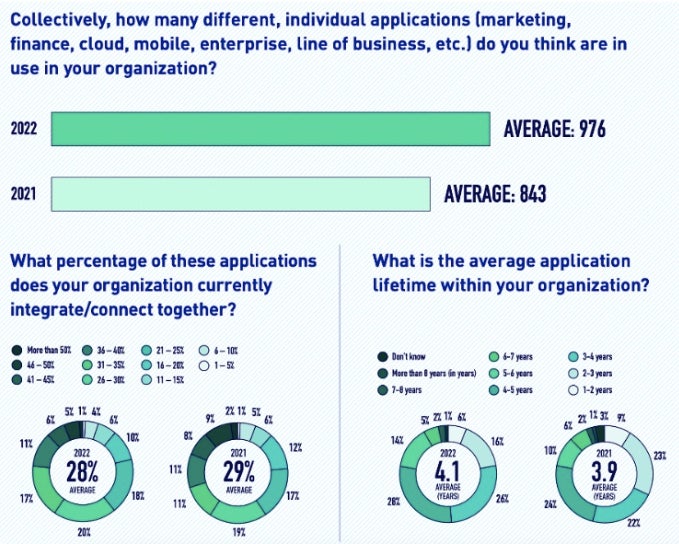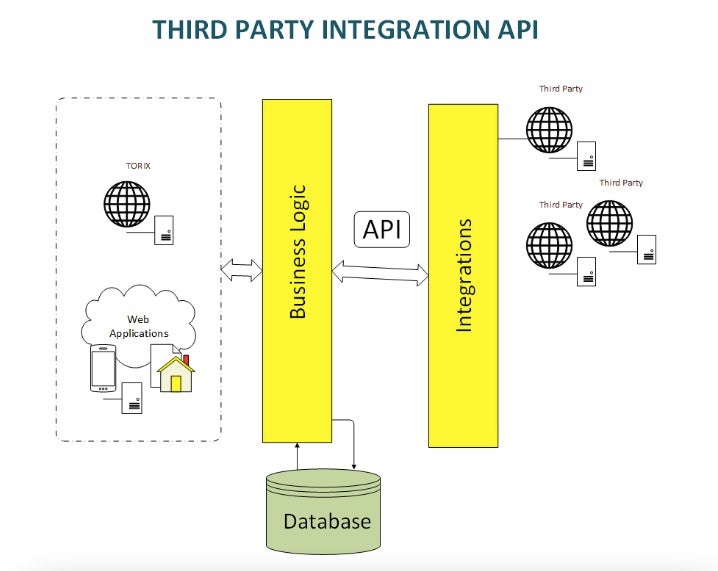Workflow integration is high on many organisations’ digital transformation agendas.
Organisations now have an average of 976 separate applications – an increase of 133 in the past 12 months. Despite this, only 28% on average, are integrated – a decrease on previous years.

(Image source: mulesoft.com)
Perhaps that’s why more than a quarter (26%) of business leaders now demand a company-wide API strategy, according to the same report. In the post-COVID world of remote working and increased workflow automation, businesses have invested heavily in process automation but neglected to keep connectivity up to date as well.
If you’ve noticed the amount of software applications you use at work increasing, it’s important that you keep data flowing between them to avoid silos, reduce human error and meet key business goals. Below, we outline what you need to know.
What is workflow integration?
Workflow integration is all about how data moves through your business, and how your employees access it.
You likely use a range of software tools across your business, pooling a huge amount of data. If these multiple platforms aren’t interconnected, data silos develop. This means that you’ll miss valuable insights and reduce operational efficiency.
Non-integrated business systems also harm your employees’ productivity. Constantly having to switch between apps to find the right information for a particular task is not only time-consuming, it interrupts flow, whilst increasing the risk of human error.
Workflow integration is the process of connecting your applications together in one overarching digital workplace – like the Claromentis Digital Workplace solution – so they share data freely, making routine tasks easier for your employees and vastly increasing the scope for valuable data analysis.
Workflow integration vs workflow automation: What’s the difference?
Workflow automation involves using a workflow automation system to automate repetitive tasks within a workflow, or to automate an entire workflow from start to finish.
Workflow integration focuses exclusively on how your different business processes and the apps that run them interconnect. To build seamless workflows that connect complex business processes, some degree of workflow automation is usually necessary.
What are the benefits of workflow integration?
The benefits of workflow integration fall into three key areas:
- Enhanced potential for data analytics
- More time for employees to focus on meaningful work
- Reduction of costly human errors
The more data your business intelligence (BI) tools work with, the more accurate they become. For example, if you can integrate the data you generate from sales workflows with the data your marketing team holds in real time, you create a high-value dataset that can be used for personalisation and other data-led campaigns. When you expand this organisation-wide, data analytics becomes a powerful tool for forecasting and strategic analysis.
How to start integrating workflows in your organisation
You can integrate workflows by integrating the software you use to manage them. You can do this using the tools’ application programming interfaces, or APIs.
Third-party APIs connect functionalities from different apps. Think of them as a doorway through which different sets of data can be shared between platforms.

(Image source: procoders.tech)
There are three types of integration:
- Native integration: These integrations are available out of the box. Modern cloud-based systems usually offer a range of these as standard – you’re likely to see Salesforce, Microsoft Teams, Google Analytics, Google Calendar and more.
- Custom integration: These integrations need to be custom built by a software developer or engineer and will be specific to your business systems.
- Custom integration using workflow integration software: There are software tools available that allow you to build automated workflows and integrate them with other tools without having to build custom integrations from scratch.
Native integrations are often relatively simple to create. Your software will take you through the process itself, and paid plans may offer support and troubleshooting for non-technical teams. For custom integrations you’ll need the services of a software developer.
What workflow integration software will I need?
Workflow integration software can save you a huge amount of time and expense when building custom integrations. These tools simplify the processes involved and remove the need for coding expertise.
Most companies will be able to integrate everything they need using integration tools and can avoid acquiring a significant amount of technical debt in doing so – this year, organisations spent an average of $3.6 million on custom integration labour, compared to $3.5 million last year.
Legacy systems are more difficult to integrate, however, and might require extensive custom integrations that can’t be done through workflow integration software. These can be expensive and time-consuming – so think carefully about your software strategy over the coming months and years, before diving in.
One of the very best ways to start integrating your workflows is to use the Claromentis Integrated Digital Workplace platform, which provides teams with all the apps they need – from calendars and document management to e-forms, workflows, and e-learning. With social and collaboration integrations, business productivity integrations, people management integrations, document management integrations, plus the ability of our in-house development team to build custom integrations to pull data from any external business platform you use, Claromentis turns your intranet into a portal to your third-party business apps, so that your teams can access everything they need from one centralised location.
Final thoughts
As businesses rely on more apps to automate and manage workflows in remote/hybrid working environments, a solid workflow integration strategy is rapidly becoming essential.
Integrating your workflows with each other using APIs, ensures that data can flow smoothly across your business without being siloed, and that your employees aren’t distracted from valuable tasks by switching between apps or completing low-value administrative tasks.
However, with a solution like Claromentis, you can enjoy the benefits of a fully integrated digital workplace that completely unifies all your business tools to increase collaboration, communication, and productivity.

![[FREE GUIDE] HOW TO CREATE AN ONLINE COMPANY CULTURE](https://no-cache.hubspot.com/cta/default/5025095/404e6163-5acd-40fd-9d11-858bdb05ea69.png)




